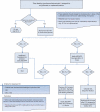Managing hyperglycemia and diabetes in patients receiving enteral feedings: A health system approach
- PMID: 25744356
- PMCID: PMC4397647
- DOI: 10.1080/21548331.2015.1022493
Managing hyperglycemia and diabetes in patients receiving enteral feedings: A health system approach
Erratum in
-
Erratum.Hosp Pract (1995). 2015;43(5):308. doi: 10.1080/21548331.2015.1071727. Hosp Pract (1995). 2015. PMID: 26691670 No abstract available.
Abstract
Evidence of poor outcomes in hospitalized patients with hyperglycemia has led to new and revised guidelines for inpatient management of diabetes. As providers become more aware of the need for better blood glucose control, they are finding limited guidance in the management of patients receiving enteral nutrition. To address the lack of guidelines in this population, Duke University Health System has developed a consistent practice for managing such patients. Here, we present our practice strategies for insulin use in patients receiving enteral nutrition. Essential factors include assessing the patients' history of diabetes, hyperglycemia, or hypoglycemia and timing and type of feedings. Insulin practices are then designed to address these issues keeping in mind patient safety in the event of abrupt cessation of nutrition. The outcome of the process is a consistent and safe method for glucose control with enteral nutrition.
Keywords: Enteral nutrition; diabetes; hyperglycemia; inpatient; nocturnal nutrition; tube feeding.
Figures



Similar articles
-
Management of Hyperglycemia and Enteral Nutrition in the Hospitalized Patient.Nutr Clin Pract. 2015 Oct;30(5):652-9. doi: 10.1177/0884533615591057. Epub 2015 Jun 17. Nutr Clin Pract. 2015. PMID: 26084507 Review.
-
Management of hyperglycemia during enteral and parenteral nutrition therapy.Curr Diab Rep. 2013 Feb;13(1):155-62. doi: 10.1007/s11892-012-0335-y. Curr Diab Rep. 2013. PMID: 23065369 Free PMC article. Review.
-
Impact of Insulin Degludec in Hospitalized Patients With and Without Type 2 Diabetes Requiring Parenteral/Enteral Nutrition: An Observational Study.Adv Ther. 2018 Jun;35(6):809-816. doi: 10.1007/s12325-018-0709-x. Epub 2018 May 17. Adv Ther. 2018. PMID: 29777522
-
Nutrition and Hyperglycemia Management in the Inpatient Setting (Meals on Demand, Parenteral, or Enteral Nutrition).Curr Diab Rep. 2017 Aug;17(8):59. doi: 10.1007/s11892-017-0882-3. Curr Diab Rep. 2017. PMID: 28664252 Review.
-
Safety and Efficacy of Insulins in Critically Ill Patients Receiving Continuous Enteral Nutrition.Endocr Pract. 2024 Apr;30(4):367-371. doi: 10.1016/j.eprac.2024.01.009. Epub 2024 Feb 1. Endocr Pract. 2024. PMID: 38307456
Cited by
-
Management of hospitalized type 2 diabetes mellitus patients.J Transl Int Med. 2016 Dec 1;4(4):155-161. doi: 10.1515/jtim-2016-0027. Epub 2016 Dec 30. J Transl Int Med. 2016. PMID: 28191539 Free PMC article.
-
Hospitalization as an Opportunity to Optimize Glycemic Control in Oncology Patients.Curr Diab Rep. 2019 Nov 27;19(12):149. doi: 10.1007/s11892-019-1283-6. Curr Diab Rep. 2019. PMID: 31776685 Review.
References
-
- Braithwaite SS, Magee M, Sharretts JM. Society of Hospital Medicine Glycemic Control Task Force. The case for supporting inpatient glycemic control programs now: the evidence and beyond. J Hosp Med. 2008;3:6–16. - PubMed
-
- Clement S. Better glycemic control in the hospital: beneficial and feasible. Cleve Clin J Med. 2007;74:111–12. 114–120. - PubMed
-
- Clement S, Braithwaite SS, Magee MF. American Diabetes Association Diabetes in Hospitals Writing Committee. Management of diabetes and hyperglycemia in hospitals. Diabetes Care. 2004;27:553–91. - PubMed
-
- Garber AJ, Moghissi ES, Bransome ED, Jr, et al. American College of Endocrinology Position statement on inpatient diabetes and metabolic control. Endocr Pract. 2004;10:77–82. - PubMed
-
- DiNardo M, Einhorn D, Umpierrez GE. American association of clinical endocrinologists and American diabetes association consensus statement on inpatient glycemic control. Endocr Pract. 2009;15(4):353–69. - PubMed
MeSH terms
Grants and funding
LinkOut - more resources
Full Text Sources
Other Literature Sources
Medical
Research Materials
